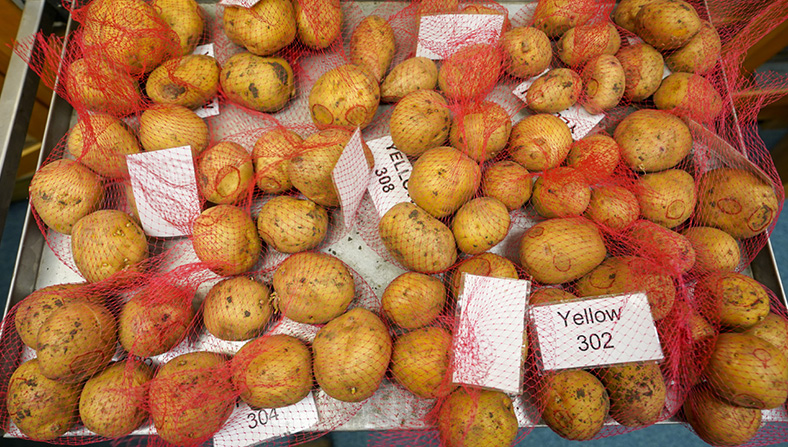Over the past three years, we have been evaluating newer cultivars and advancing selections in two different trials, one focused on red-skinned potatoes and the other on yellow-skinned potatoes. Search for “North Dakota Fresh Market Potato Cultivar/Selection Trial Results” online.
As part of these trials, sub-samples of 20 tubers harvested were placed in small mesh bags and placed into a post-harvest pressure bruise storage test bin at the U.S. Department of Agriculture-Agricultural Research Station (USDA-ARS) Potato Worksite in East Grand Forks, Minnesota.
The pressure bruise chambers were setup to simulate storage in a commercial potato bin at the USDA-ARS Potato Worksite. At harvest, a sub-sample of 20 tubers harvested in September or early October were placed in small mesh bags. All samples were weighed and placed in storage within one day of harvest. Following a period for wound healing, the temperature was slowly reduced to 42 degrees Fahrenheit with 95% relative humidity and an airflow of 1.5 cfm/cwt. A pressure plate was used to provide pressure by incrementally increasing the pressure until it reached 2.1 lb/inch2 to simulate pile pressure. Potato tubers remained in the pressure bruise chamber for about five to six months until February or early March. After removing the tubers, they were weighed, and the number and size of pressure bruises were measured.
Standard cultivars were used as benchmarks for other entries, including Red Norland, Dark Red Norland, Red Pontiac and Sangre. For the yellows, industry standards included Actrice, Agata, Musica and Alegria, serving as benchmarks, depending on the variety you have experience with on your farm operation.
Differences were found among clones for most qualities. Sangre, W8890-1R and Roko (Table 1) were the best storage red clones in 2019-2021. They consistently had fewer pressure bruises, average smaller bruise area and less weight loss following storage. For the yellow-skinned clone trial, only data from 2020-2021 is presented (Table 2) because the 2019 harvest was interrupted by a snowstorm. Of the yellows tested, the data indicate more variability. NDA081451, Obama, CO05037-3, CO10064-1, Actrice and Lanorma had fewer pressure bruises, smaller average bruise area and less weight loss following storage.
The data presented in Tables 1 and 2 were analyzed statistically. These analyses allow the reader to ascertain, at a predetermined level of confidence, if the differences observed among cultivars/selections are reliable or if they might be due to error inherent in the experimental process.
The LSD (least significant difference) values beneath the columns apply only to the numbers in the column in which they appear. If the difference between two cultivars/selections exceeds the LSD value at 0.05, it indicates with 95% confidence the higher-yielding cultivar/selection significantly differs. An LSD value of 0.1 indicates a 90% confidence or nine times out of ten a difference will be found. When the difference between two cultivars/selections is less than the LSD value, no significant difference was found between the two clones under these storage conditions.
Coefficient of variation (CV) is expressed as a percentage. The CV is a measure of variability in the trial. Large CVs mean a large amount of variation that could not be attributed to differences in the cultivars/selections.
Table 1. Pressure bruising (flattening) results of red-skinned potato trials from 2019-2021, following five to six months of storage with the temperature of 42 degrees Fahrenheit with 95% relative humidity, and an airflow of 1.5 cfm/cwt at East Grand Forks, MN.
| Cultivar/selection | Tuber diameter | Bruises/tuber | Mean bruise area/tuber | Average bruise size | Weight loss |
|---|
| | --- inch --- | --- number --- | ---------- inch2 ---------- | --- % --- |
| Autumn Rose | 2.1 | 4.7 | 2.5 | 0.54 | 8.9 |
| Cerata | 2.4 | 4.0 | 2.4 | 0.64 | 7.5 |
| CO99076-6R | 2.3 | 4.7 | 3.1 | 0.69 | 9.8 |
| Dark Red Norland | 2.3 | 4.1 | 2.6 | 0.70 | 7.8 |
| Dark Red Norland (Real Potato) | 2.4 | 3.8 | 2.2 | 0.61 | 7.2 |
| ND113207-1R | 2.3 | 4.0 | 2.2 | 0.61 | 7.2 |
| Red Norland | 2.5 | 3.4 | 2.0 | 0.62 | 6.4 |
| Red Pontiac | 2.5 | 3.5 | 2.2 | 0.66 | 7.5 |
| Roko | 2.3 | 2.8 | 1.4 | 0.49 | 5.8 |
| Sangre | 2.3 | 2.2 | 1.2 | 0.48 | 6.0 |
| W8890-1R | 2.4 | 3.7 | 1.9 | 0.55 | 6.1 |
| Mean | 2.3 | 3.7 | 2.2 | 0.60 | 7.3 |
| CV | 8 | 34 | 33 | 25 | 15 |
| LSD p=0.05 | 0.1 | 1.0 | 0.6 | 0.12 | 0.9 |
| LSD p=0.1 | 0.1 | 0.9 | 0.5 | 0.10 | 0.8 |
Image 1. Red-skinned potato tubers out of pressure bin with marks on flattening spots.
Table 2. Pressure bruising (flattening) results of the yellow-skinned potato trial, following five to six months of storage with the temperature of 42 degrees Fahrenheit with 95% relative humidity, and an airflow of 1.5 cfm/cwt at East Grand Forks, MN.
| Cultivar/selection | Tuber diameter | Bruises/tuber | Mean bruise area/tuber | Average
bruise size | Weight loss |
|---|
| | --- inch --- | --- number --- | ---------- inch2 ---------- | --- % --- |
| A00286-3Y | 2.3 | 2.7 | 1.2 | 0.47 | 5.2 |
| Actrice | 2.5 | 2.2 | 1.1 | 0.57 | 4.9 |
| Agata | 2.4 | 2.8 | 1.4 | 0.53 | 5.1 |
| Alegria | 2.5 | 3.2 | 1.8 | 0.57 | 6.5 |
| Arizona | 2.4 | 3.4 | 1.7 | 0.54 | 5.7 |
| Belmonda | 2.3 | 3.8 | 2.0 | 0.56 | 7.6 |
| CO05037-3 | 2.3 | 1.9 | 0.8 | 0.44 | 4.4 |
| CO10064-1 | 2.2 | 2.1 | 1.1 | 0.54 | 4.7 |
| CO11250-1 | 2.0 | 2.6 | 1.1 | 0.44 | 5.9 |
| CO11266-1 | 2.0 | 2.7 | 1.3 | 0.46 | 8.0 |
| Crop 56 | 2.0 | 3.0 | 1.3 | 0.44 | 6.8 |
| Crop 58 | 2.4 | 2.8 | 1.5 | 0.57 | 6.9 |
| Crop 80 | 2.3 | 3.0 | 1.5 | 0.53 | 6.7 |
| Electra | 2.4 | 2.4 | 1.2 | 0.49 | 4.8 |
| Jelly | 2.3 | 3.0 | 1.8 | 0.58 | 6.2 |
| Lanorma | 2.5 | 2.2 | 1.1 | 0.48 | 5.3 |
| Montreal | 2.5 | 2.3 | 1.3 | 0.55 | 5.4 |
| Musica | 2.2 | 3.2 | 1.7 | 0.54 | 6.5 |
| ND1241-1Y | 2.3 | 2.3 | 1.1 | 0.49 | 5.8 |
| ND1487-1Y | 2.1 | 2.7 | 1.5 | 0.56 | 7.4 |
| NDA081451 | 2.4 | 1.5 | 0.7 | 0.50 | 5.4 |
| Noelle | 2.1 | 2.5 | 1.1 | 0.47 | 5.4 |
| Obama | 2.3 | 1.7 | 0.8 | 0.48 | 4.0 |
| Paroli | 2.4 | 3.4 | 2.0 | 0.60 | 6.5 |
| W15240-2Y | 2.2 | 3.9 | 2.0 | 0.54 | 8.2 |
| Mean | 2.3 | 2.7 | 1.4 | 0.52 | 6.0 |
| CV | 8 | 27 | 36 | 28 | 17 |
| LSD p=0.05 | 0.2 | 0.7 | 0.5 | ns | 1.0 |
| LSD p=0.10 | 0.1 | 0.6 | 0.4 | ns | 0.8 |
Image 2. Yellow-skinned potato tubers out of pressure bin with marks on flattening spots.
The data provided does not indicate endorsement or approval by the authors, NDSU Extension, University of Minnesota Extension or USDA-ARS. Reproduction of the tables is permissible if presented with all the same information found in this publication (meaning no portion is deleted and the order of the data is not rearranged).
The authors acknowledge the contribution of cultivars and advanced selections for this work from the breeding programs at North Dakota State University, the University of Minnesota, the U.S. Department of Agriculture-Agricultural Research Service, Colorado State University, the University of Wisconsin, Michigan State University, Ebe Farms, Northern Konstar Potatoes, Parkland Seed, Real Potato, Solanum, Southern Potato and SunRa
NDSU Extension does not endorse commercial products or companies even though reference may be made to tradenames, trademarks or service names. NDSU encourages you to use and share this content, but please do so under the conditions of our Creative Commons license. You may copy, distribute, transmit and adapt this work as long as you give full attribution, don’t use the work for commercial purposes and share your resulting work similarly.
For more information on this and other topics, see https://www.ndsu.edu/agriculture/extension.
County commissions, North Dakota State University and U.S. Department of Agriculture cooperating. NDSU does not discriminate in its programs and activities on the basis of age, color, gender expression/identity, genetic information, marital status, national origin, participation in lawful off-campus activity, physical or mental disability, pregnancy, public assistance status, race, religion, sex, sexual orientation, spousal relationship to current employee, or veteran status, as applicable. Direct inquiries to Vice Provost for Title IX/ADA Coordinator, Old Main 201, NDSU Main Campus, 701-231-7708, ndsu.eoaa@ndsu.edu. This publication will be made available in alternative formats for people with disabilities upon request, 701-231-7881. 50-6-22





